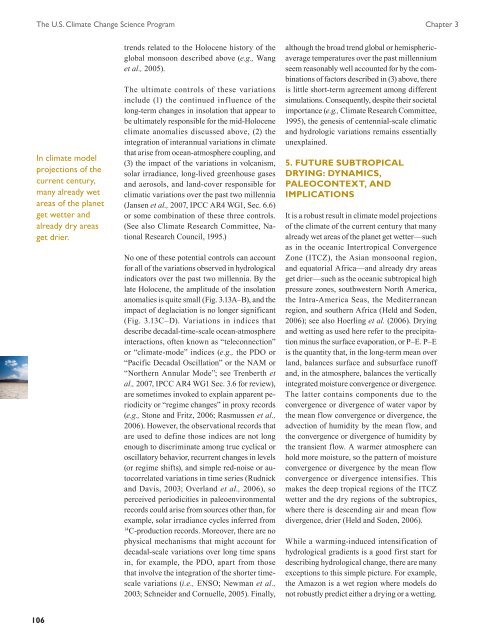Book 2.indb - US Climate Change Science Program
Book 2.indb - US Climate Change Science Program
Book 2.indb - US Climate Change Science Program
- No tags were found...
Create successful ePaper yourself
Turn your PDF publications into a flip-book with our unique Google optimized e-Paper software.
The U.S. <strong>Climate</strong> <strong>Change</strong> <strong>Science</strong> <strong>Program</strong>Chapter 3In climate modelprojections of thecurrent century,many already wetareas of the planetget wetter andalready dry areasget drier.trends related to the Holocene history of theglobal monsoon described above (e.g., Wanget al., 2005).The ultimate controls of these variationsinclude (1) the continued influence of thelong-term changes in insolation that appear tobe ultimately responsible for the mid-Holoceneclimate anomalies discussed above, (2) theintegration of interannual variations in climatethat arise from ocean-atmosphere coupling, and(3) the impact of the variations in volcanism,solar irradiance, long-lived greenhouse gasesand aerosols, and land-cover responsible forclimatic variations over the past two millennia(Jansen et al., 2007, IPCC AR4 WG1, Sec. 6.6)or some combination of these three controls.(See also <strong>Climate</strong> Research Committee, NationalResearch Council, 1995.)No one of these potential controls can accountfor all of the variations observed in hydrologicalindicators over the past two millennia. By thelate Holocene, the amplitude of the insolationanomalies is quite small (Fig. 3.13A–B), and theimpact of deglaciation is no longer significant(Fig. 3.13C–D). Variations in indices thatdescribe decadal-time-scale ocean-atmosphereinteractions, often known as “teleconnection”or “climate-mode” indices (e.g., the PDO or“Pacific Decadal Oscillation” or the NAM or“Northern Annular Mode”; see Trenberth etal., 2007, IPCC AR4 WG1 Sec. 3.6 for review),are sometimes invoked to explain apparent periodicityor “regime changes” in proxy records(e.g., Stone and Fritz, 2006; Rasmussen et al.,2006). However, the observational records thatare used to define those indices are not longenough to discriminate among true cyclical oroscillatory behavior, recurrent changes in levels(or regime shifts), and simple red-noise or autocorrelatedvariations in time series (Rudnickand Davis, 2003; Overland et al., 2006), soperceived periodicities in paleoenvironmentalrecords could arise from sources other than, forexample, solar irradiance cycles inferred from14C-production records. Moreover, there are nophysical mechanisms that might account fordecadal-scale variations over long time spansin, for example, the PDO, apart from thosethat involve the integration of the shorter timescalevariations (i.e., ENSO; Newman et al.,2003; Schneider and Cornuelle, 2005). Finally,although the broad trend global or hemisphericaveragetemperatures over the past millenniumseem reasonably well accounted for by the combinationsof factors described in (3) above, thereis little short-term agreement among differentsimulations. Consequently, despite their societalimportance (e.g., <strong>Climate</strong> Research Committee,1995), the genesis of centennial-scale climaticand hydrologic variations remains essentiallyunexplained.5. Future SubtropicalDrying: Dynamics,Paleocontext, andImplicationsIt is a robust result in climate model projectionsof the climate of the current century that manyalready wet areas of the planet get wetter—suchas in the oceanic Intertropical ConvergenceZone (ITCZ), the Asian monsoonal region,and equatorial Africa—and already dry areasget drier—such as the oceanic subtropical highpressure zones, southwestern North America,the Intra-America Seas, the Mediterraneanregion, and southern Africa (Held and Soden,2006); see also Hoerling et al. (2006). Dryingand wetting as used here refer to the precipitationminus the surface evaporation, or P–E. P–Eis the quantity that, in the long-term mean overland, balances surface and subsurface runoffand, in the atmosphere, balances the verticallyintegrated moisture convergence or divergence.The latter contains components due to theconvergence or divergence of water vapor bythe mean flow convergence or divergence, theadvection of humidity by the mean flow, andthe convergence or divergence of humidity bythe transient flow. A warmer atmosphere canhold more moisture, so the pattern of moistureconvergence or divergence by the mean flowconvergence or divergence intensifies. Thismakes the deep tropical regions of the ITCZwetter and the dry regions of the subtropics,where there is descending air and mean flowdivergence, drier (Held and Soden, 2006).While a warming-induced intensification ofhydrological gradients is a good first start fordescribing hydrological change, there are manyexceptions to this simple picture. For example,the Amazon is a wet region where models donot robustly predict either a drying or a wetting.106






